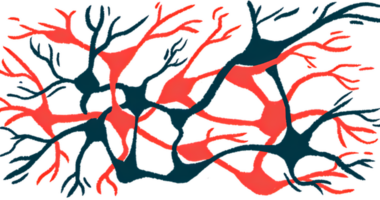Compound ID’d that may reduce Parkinson’s brain inflammation
MFP-0012328 blocks a protein that's instrumental in microglial activity

An experimental compound has been identified that shows the potential to reduce brain inflammation in neurodegenerative conditions such as Parkinson’s disease.
MFP-0012328 works by blocking FABP4, a protein that researchers have shown to be key in the inflammatory activity of microglia, the brain’s immune cells. While other FABP4 suppressors have been studied, this one appears to show the most pronounced effects and favorable properties for reaching the brain.
“Neurodegenerative diseases are particularly challenging to treat, with no known cure available for most people living with Alzheimer’s disease, Parkinson’s disease and motor neuron disease,” Joseph Nicolazzo, PhD, the study’s senior author at Monash University’s Monash Institute of Pharmaceutical Sciences (MIPS) in Australia, said in a university press release. “Although our drug discovery program has a long way to go, we are excited to have identified a promising approach to enable the next step in the drug development process.”
Nicolazzo is also a professor and the director of MIPS’s Center for Drug Candidate Optimization.
The findings were described in the study, “Evaluation of the Anti-Inflammatory Effects of Novel Fatty Acid-Binding Protein 4 Inhibitors in Microglia,” which was published in the Journal of Neuroimmune Pharmacology.
The causes of Parkinson’s disease aren’t completely understood, but available data suggest that uncontrolled brain inflammation, or neuroinflammation, plays a central role in driving it and other neurodegenerative conditions. Microglia are thought to be principle actors in disease-driving neuroinflammation.
Targeting the FABP4 protein
Nicolazzo and his research team previously showed that inflammatory microglia produce high levels of FABP4, suggesting that therapies that suppress the protein may reduce the cells’ inflammatory activity.
However, the characteristics of commercially-available FABP4-targeting drugs so far “prevent their ability to be easily formulated and traverse the blood–brain barrier (BBB) in order to access microglial FABP4,” the researchers wrote. The BBB is a highly selective membrane that prevents large molecules and microbes in circulation from entering the brain and spinal cord. While this is meant to keep it safe from infections and potentially harmful molecules, it can make it hard to design medicines to get into the brain.
“There is therefore a need to develop compounds that are not only able to bind potently and selectively to FABP4, but also exhibit [physical and chemical] properties for optimum BBB penetration so as to more efficiently alleviate microglial-mediated neuroinflammation,” the researchers wrote.
Martin Scanlon, a study author and a professor at MIPS, said that “for the last few years, medicinal chemists at MIPS have been elaborating compounds that were identified by fragment screening to develop new FABP4 [suppressors] with more drug-like properties that are capable of getting through the [BBB].”
Four such compounds were tested in cell experiments for their ability to block microglial inflammatory activity. While all four compounds reduced the inflammatory activity of microglia, MFP-0012328 was especially potent. The compound also has other properties that make it well suited for penetrating the BBB and easing neuroinflammation.
“Of the four FABP4 inhibitors we assessed, there was one that markedly alleviated microglia-induced neuroinflammation, and its [physical and chemical] properties are much more aligned with what we’d like for good [BBB] permeability,” Nicolazzo said.
The study is a first step, said the researchers, who emphasized that more research is needed before MFP-0012328 can be tested in people as a possible treatment for Parkinson’s or other neurodegenerative disorders.
“Further studies such as drug characterization, pharmacokinetic/pharmacodynamic studies, and efficacy studies should be performed to support the proposal that MFP-0012328 could indeed be a potential therapeutic compound that may be used to alleviate microglia-induced neuroinflammation in many neurodegenerative diseases,” they wrote. Pharmacokinetics refers to a therapy’s movement into, through, and out of the body, while pharmacodynamics describes a therapy’s effects on the body.







